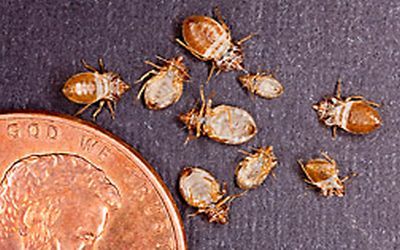Scientists Studying Bed Bug Behavior for New Management Tactics
The resurgence of bed bugs over the last decade has caused problems in major U.S. cities where they infest homes, apartments, hotels, shelters and even places of work. The small, blood-feeding insects are not known to transmit diseases, but they can cause severe reactions in people who are allergic to them. Bed bugs usually go unnoticed until their numbers increase significantly, and getting rid of them can be costly.


A penny provides a sense of scale to the size of bed bug skins collected for analysis by ARS scientists in Beltsville, Md. Photo by Stephen Ausmus.
By Sandra Avant
The resurgence of bed bugs over the last decade has caused problems in major U.S. cities where they infest homes, apartments, hotels, shelters and even places of work. The small, blood-feeding insects are not known to transmit diseases, but they can cause severe reactions in people who are allergic to them. Bed bugs usually go unnoticed until their numbers increase significantly, and getting rid of them can be costly.
Entomologist Mark Feldlaufer and chemist Kamlesh Chauhan at the Agricultural Research Service (ARS) Henry A. Wallace Beltsville Agricultural Research Center (BARC) in Beltsville, Md., have identified two new alarm pheromones4-oxo-hexenal and 4-oxo-octenalin immature bed bugs. The releasing of alarm pheromones, which are defensive compounds, causes aggregated bed bugs to scatter.
Scientists collected cast skins that retain chemicals from the bed bug's scent glands and then used gas chromatography and mass spectrometry technology to analyze and identify compounds. Swedish researchers subsequently identified the same compounds from a related species, the tropical bed bug, demonstrating that the compounds are biologically active.
This indicates that alarm pheromones may have implications in bed bug management, according to Feldlaufer, who works at BARC's Invasive Insect Biocontrol and Behavior Laboratory. By causing insects to disperse, the likelihood of bed bugs coming into contact with a control agent increases.
ARS and University of Nevada-Reno scientists also identified 17 compounds in the bed bug's outer protective layer of skin, a discovery they believe may play an important role in bed bug aggregation behavior.
This research is featured in the February 2013 issue of Agricultural Research magazine.
ARS is USDA's principal intramural scientific research agency.
Â
Infection Intel: Revolutionizing Ultrasound Probe Disinfection With Germitec's Chronos
November 19th 2024Learn how Germitec’s Chronos uses patented UV-C technology for high-level disinfection of ultrasound probes in 90 seconds, enhancing infection control, patient safety, and environmental sustainability.
Clean Hospitals Corner With Alexandra Peters, PhD: The Issues Around Outsourcing
November 7th 2024Outsourcing environmental hygiene in health care facilities offers cost benefits but often compromises quality. Effective oversight, training, and standards are essential for ensuring patient safety.
Strengthening Defenses: Integrating Infection Control With Antimicrobial Stewardship
October 11th 2024Use this handout to explain the basics of why infection prevention and control and antimicrobial stewardship are essential and how the 2 fields must have a unified approach to patient and staff safety